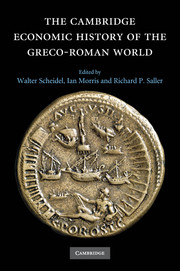Crossref Citations
This Book has been
cited by the following publications. This list is generated based on data provided by Crossref.
Scheidel, Walter
2003.
The Greek demographic expansion: models and comparisons.
The Journal of Hellenic Studies,
Vol. 123,
Issue. ,
p.
120.
Hin, Saskia
2007.
Family Matters: Economy, Culture and Biology: Fertility and Its Constraints in Roman Italy.
SSRN Electronic Journal,
Scheidel, Walter
2008.
The New Palgrave Dictionary of Economics.
p.
1.
Longenecker, Bruce W.
2009.
Exposing the Economic Middle: A Revised Economy Scale for the Study of Early Urban Christianity.
Journal for the Study of the New Testament,
Vol. 31,
Issue. 3,
p.
243.
Kennedy, David
2009.
The Demise of the Decapolis. Past and Present Desertification in the Context of Soil Development, Land Use, and Climate.
Journal of Archaeological Science,
Vol. 36,
Issue. 12,
p.
2884.
2009.
Building Cycles.
p.
394.
Scheidel, Walter
2009.
Roman Wellbeing and the Economic Consequences of the 'Antonine Plague'.
SSRN Electronic Journal,
2010.
A Companion to Ancient Macedonia.
p.
599.
Scheidel, Walter
2010.
Approaching the Roman Economy.
SSRN Electronic Journal,
2010.
The Land of Ionia.
p.
235.
Scheidel, Walter
2010.
Roman Real Wages in Context.
SSRN Electronic Journal,
Scheidel, Walter
2010.
Slavery in the Roman Economy.
SSRN Electronic Journal,
2010.
A Companion to Families in the Greek and Roman Worlds.
p.
567.
Duyrat, Frédérique
2010.
Bibliographie numismatique de la Syrie - IV. Périodes achéménide, hellénistique, romaine et byzantine (2006-2007) .
Syria,
p.
301.
Dari-Mattiacci, Giuseppe
and
Guerriero, Carmine
2011.
Law, Economics and History: Endogenous Institutional Change and Legal Innovation.
SSRN Electronic Journal,
Hurlet, Frédéric
2011.
(Re) penser l'Empire romain. Le défi de la comparaison historique.
Dialogues d'histoire ancienne,
Vol. S5,
Issue. Supplement5,
p.
107.
Parker, Grant
2011.
India, Egypt and Parthia in Augustan verse: the post-orientalist turn.
Dictynna,
Bradley, Keith
and
Cartledge, Paul
2011.
The Cambridge World History of Slavery.
Scheidel, Walter
2012.
The Cambridge Companion to the Roman Economy.
Palmer, Ruth
2012.
The Encyclopedia of Ancient History.



